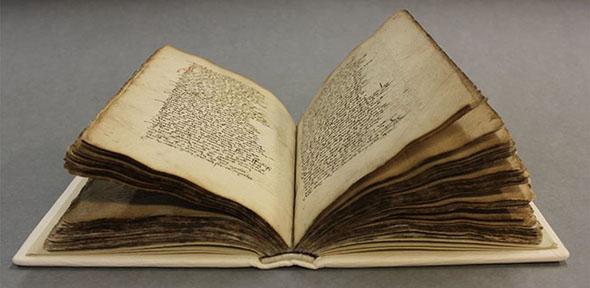It is one of the best-known works written in early Scots and its central theme - that freedom is a prize worth winning at all costs - has resonated in Scotland through the ages and is a poignant reminder before the Scottish Independence Referendum.
No edition of the 1,400 line poem written in Barbour’s own hand survives, but two early versions, transcribed in the 15th century, still exist. These are kept at the Library of St John’s College, in Cambridge, and at the National Library of Scotland, Edinburgh. After centuries of use, the St John’s manuscript had become badly damaged. The great majority of its pages were torn, sections were difficult to read because of dirt and marking, and the volume was so tightly bound it could not be opened without damaging the pages further, making the document virtually unusable.
Last year, the College commissioned specialists from the Cambridge Colleges’ Conservation Consortium to conserve the text, with support from the National Manuscripts Conservation Trust. Over months of painstaking work, it was systematically taken apart, cleaned, repaired and rebound in a style more appropriate to its age.

Credit: Kathryn McKee, Cambridge Colleges’ Conservation Consortium
The result is an expertly and sympathetically repaired manuscript of The Brus which scholars of the Scottish Wars, or medieval literature, will be able to use in full. Along with many of the other priceless materials in the Library’s special collections, it will also be available for visiting groups to examine, and will periodically go on public display.
“The 700th anniversary essentially gave us the impetus for doing the work,” Kathryn McKee, Special Collections Librarian at St John’s College, said. “It’s likely to result in a fresh wave of interest in Bannockburn and we wanted the book to be available in a fit state.”
The St John’s edition of The Brus was given to the College in the 1630s by Thomas, fourth Earl of Southampton. It was written in 1487, and is thought to have been transcribed by John Ramsay, Prior of the Carthusians at Perth. Quite unusually for a surviving manuscript of this time, it is written on high-quality rag paper, which, as the name suggests, was made from pulped textile rags. Unfortunately, at some point during the late 18th or early 19th century, the book was rebound rather poorly and exposed to considerable damage during the process as a result.
Although it was still regularly consulted in the years that followed, by the time the conservators were called in it was in a very fragile state. Many of the pages could barely be prised apart enough to take a photograph of their contents, without causing further damage still.
The delicate repair operation required the specialists to remove the binding, and lift the modern spine-liners and glue. Surface dirt was gently dry-cleaned from the pages, tears in the paper were repaired, and dog-eared corners flattened out. The manuscript was then resewn according to the original, 15th-century pattern, and rebound with traditional materials.
Source: Cambridge University





Comments